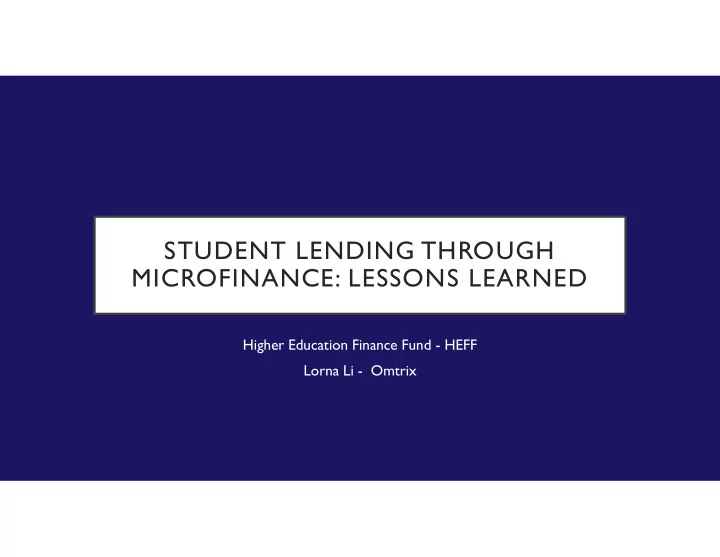

STUDENT LENDING THROUGH MICROFINANCE: LESSONS LEARNED Higher Education Finance Fund - HEFF Lorna Li - Omtrix
THE HIGHER EDUCATION FINANCE FUND Purpose: T o finance higher education for low-income people • Leverages existing MFIs and other bottom-of-the-pyramid institutions • 10-year, $33 million fund incorporated in December 2011 • $1.6 million technical assistant facility (TAF) • Pay back based on Cash Flow Analysis taking into consideration selected career • General Manager for fund and TA:: Omtrix Inc , fund manager and financial consultant headquartered in Costa Rica and working in the MF industry since 1995
HEFF AT A GLANCE Bolivia Peru • Equity funders: KfW, Norfund, SIFEM/OBVIAM, 6% 13% LMDF, CAF, Calvert Costa Rica 8% • Debt funders: OPIC, KfW, SIFEM/OBVIAM, Calvert, Deutsche Bank Paraguay 8% • Grants: USAID, MasterCard Foundation, KfW Honduras • 10 microfinance institutions, 7 countries 8% • T otal Portfolio as of September 2017: $25.75 Dominican million Republic 36% Guatemala 21%
TOTAL STUDENT LOAN PORTFOLIO As of September 2017… Higher Education Center by Type • 5,401 students have been financed Other • $14.9 million has been disbursed to students 2% T echnical 24% Gender Breakdown Family Income Bracket (USD) 60% Undergraduate 50% University Male 40% 74% 46% 30% Female 20% 54% 10% 0% < $730 $731 - $1,216 $1,217 - $1,654 > $1,655 Family Income Bracket (USD)
SPOTLIGHT: FUNDAPEC HEFF’ S L OAN TO FUNDAPEC EIB´s Loan to Fundapec • Term: 9 years , 4 years grace • Total amount: €5 million • Total amount: $3.5 million • Term: 7 years Variable interest rate: Local rate + margin 3.46%. (Floor 10%) • Interest rate: below market conditions • Higher Education Center by Type T echnical 1% Gender Breakdown Family Income Bracket (USD) 60% 50% Male 40% 45% 30% Female Undergraduate 20% 55% University 10% 99% 0% < $730 $731 - $1,216 $1,217 - $1,654 > $1,655 Family Income Bracket (USD)
LESSONS LEARNED
REACHING A NEW CLIENT New market segment • Expectation: Lend to children of existing clients. • Reality: Issues of co-signer indebtedness, too small a market, children expected to run business. • Expectation: Full-time students age 18 to 22 • Reality: Average age 25, part-time, working students • Problem Youthful clients, many new to the institution, do not respond to traditional media (radio, newspaper, etc.). • Solution Digital, dynamic advertising on social media (videos online, facebook, WhatsApp responsiveness)
REACHING A NEW CLIENT (CONT.) New marketing channels and alliances • Alliances with universities, technical institutes, and other higher education centers to meet latent demand • Reach students when they inquire about school • Pay school directly when disbursing loans Synchronize payments with school calendar • • Digital communication with institution online, with quick responses and information disseminated via a student loans-only product page on facebook, on website, etc. • Messaging on aspirations, investment in your future, not the technical details of the product.
BREAKING AWAY FROM TRADITIONAL STUDENT LOANS • Expectation: Long term loans, double the length of study, grace period on principal payments during study • Reality: Part-time working students don’t want such long-term loans (or grace periods). Loans had to be adapted to meet clients’ demands • Some full-time students did prefer the original loan product. • Preference between long term v. short term is also cultural (by country or target market segment) • Guarantors are a necessary requirement (often parents), and some institutions asked for real guarantees from guarantors backing larger loans.
INTEGRATING THE PRODUCT INTO MFI’S OPERATIONS Focus of Product Launch Process Marketing: Take time Management: Lower to know your new margin product, branch market segment managers may not fully Start with targeted embrace as they chase regions/branches their quarterly goals. IT: Student loans are Staff : Credit officers data intense. Prepare may be reluctant to IT systems for smooth place student loans integration. • Time intensive/fewer conversions • Cyclical in nature
EVALUATING PRODUCT PROFITABILITY V. WORTHINESS • Lower margin product has other value to board/executive management, such as • Reaching a new demographic, possibility of cross-selling products and growing market share • Meets social bottom line and fulfills institutional mission • Good for staff morale (particularly in cases where staff could access student loans on preferential terms)
CHAMPIONING THE PRODUCT INTERNALLY Internal Champion critical to success. Institutions struggled until they truly empowered a product champion. • Senior enough to be heard and respected • Given the proper tools and incentives to succeed. • In the early stages, only focuses on student loans. • In some cases and where affordable, dedicated student loan credit officers who specialize in student loans. T eam is given greater freedom and encouragement to work • with schools and respond to students through non-traditional avenues, such as WhatsApp.
LESSONS FOR TECHNICAL ASSISTANCE PROGRAMS/CONSULTANTS • T echnical assistance programs should accompany the institution through product development and launch. • On-going support of product integration at the institutional level is vital. • Support on marketing for younger clients also useful (e.g. online videos and youth-focused branding) • Problem Methodology and market studies created pre-launch require adjustments post-launch to meet nuanced needs of market • Solution Design product with the institution. Consulting-intensive.
LESSONS FOR FUNDERS • Patient capital that can wait for lengthy product implementation phases • MFIs Interested in TA; provision of lines of credit in most cases was not needed. • Social returns trump financial, as student loans are low-margin. • Risk absorption as institutions will see student loans as “too risky” and may change the core of the product to avoid risk
CONTACT INFORMATION Lorna Li Email: lornali@omtrixinc.com Phone: (506) 22 20 41 22 Web Site: http://heff-education.com/ Mid-term evaluation: http: //heff-education.com/eng/case-analysis/
Recommend
More recommend